A Graphic Designer Developes a Campaign Poster The Purpose of Art It
This section showcases 5 different posters, each with a specific bulletin, look and feel.
- Affiche ane: We can practise it!
- Affiche ii: NO NUKES IN THE PACIFIC
- Poster 3: Live Assist/Live 8
- Poster 4: UN Women
- Affiche v: Real Australians Say Welcome
Activity: Favourite campaign posters
Step i: In your group, look at your given poster. Read the 'learn' section linked to it, and consummate the related activities.
Pace 2: Present dorsum to the other group.
Step three: In pairs, discuss: if yous could apply the epitome of Rosie the Riveter or Lord Kitchener (from the 1914 poster) for ane social or political issue today, which would y'all choose? Would you change the effigy? What text would you use? Create an cribbing of the poster using Adobe Photoshop or collage.
Poster i: We can practise it!
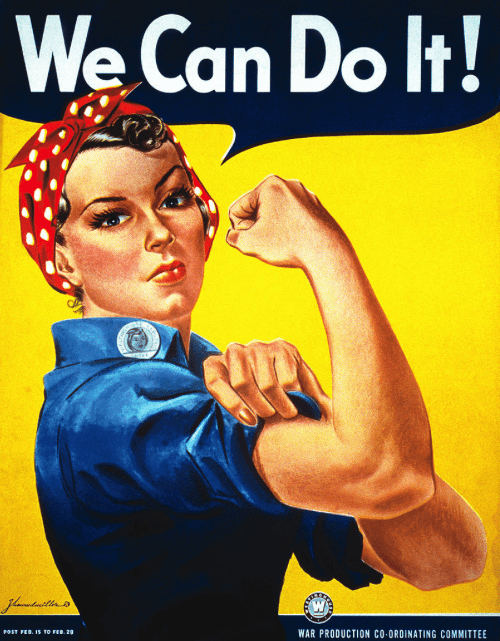
Learn
"We Can Do It!", 1943, by J. Howard Miller was made as an inspirational image for Westinghouse-Electric to boost their female person worker morale during the second globe state of war. During this fourth dimension its was viewed past a very express audience of employees but the affiche has had a 2d life. Information technology was 'rediscovered' in the 1980s to promote feminism and other political issues.
The poster uses bold primary colours (red, yellowish and blue), has a strong and simple message (the word "we" suggests teamwork and support) and an prototype of a female that conveys strength and positive action. The woman in the prototype is rolling up her blueish shirt sleeves, tensing her biceps and staring directly at the viewer, in a phone call to action. The background is a flat yellowish and a dark blue oral communication bubble fills the top quarter of the image. The option of typography is simple and bold. These days the poster is seen every bit a symbol of women's empowerment.
Over the past 30 years the poster has been appropriated for a range of advertizement and creative purposes including by the singer Beyonce and strangely, a cleaning visitor.
It's actually powerful because it'due south an iconic image of a strong adult female, which has gone on to symbolise much more than than what was originally intended.
— Sarah Rogan, Inequality Entrada Lead, Oxfam Australia
Think and Deed
- "We can do information technology" is a positive and encouraging phrase. Can you think of whatsoever other slogans with a positive and persuasive message? Make a listing of campaign slogans that appeal to the masses in a positive way. Document your favourites in your art or design diary.
- Rosie the Riveter has become a feminist symbol. Research the diverse appropriations of this poster. You lot tin can discover hundreds of examples on (pinterest). Consider the intentions for each campaign.
Do you think the appropriation fits the accepted symbolism of the original paradigm? Use the following questions to guide your annotations:
- Note the similarities between the ii posters
- Notation the differences between the two posters
- Does the artist use humour? How?
- Does the artist aim to challenge conventions? How?
- Does the artist apply irony or parody? How?
Poster two: No Nukes in the Pacific
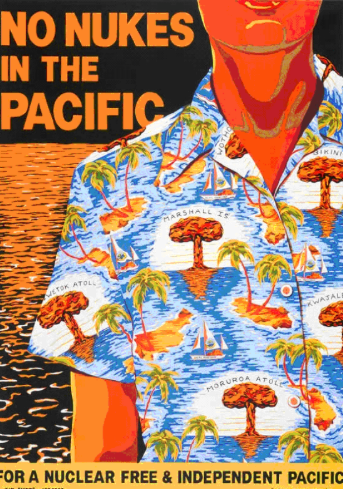
Acquire
"NO NUKES IN THE PACIFIC", was created in 1984 by Pam Debenham equally role of the Tin Sheds Poster Commonage. Debenham described the poster as her protestation against the build-upwards of nuclear weapons and particularly the nuclear testing existence conducted by French, British and United states governments in the Pacific ocean during the early 1980s.
The kitsch and familiar tropical vacation shirt has been replaced by imagery depicting atolls, nuclear clouds and the names of atolls where testing has already taken place. Debenham has used the postmodern techniques of cribbing, irony and juxtaposition. The affiche is dominated past the complementary colours of blueish and orangish and the bold text in the top left corner works to reinforce the message conveyed in the imagery of paradise being destroyed on the shirt.
There are several campaign and protestation posters that have stuck in my mind. This ane was made in 1984, when the superpowers were collecting arms and blasting/testing in the Pacific ocean. The nuclear tropical shirt is an inspired idea! Just a really clever way of proverb 'Don't destroy paradise, dummies!'
— Steph Hughes, Illustrator and Designer
Think and Deed
- What does this poster aim to enhance sensation about?
- The artist has used a limited colour palette. What is the result of this pick?
- Draw a typical 'Hawaiian' shirt and the imagery associated with it. Why do you call up Pat Debenham chose to appropriate a Hawaiian shirt for this poster?
- Are there other social and political issues that 1 might use an Hawaiian shirt impress to draw attending to?
- Pattern a poster that appropriates Debenham'southward graphic mode, with bold outlines, a flat and restricted colour palette and a articulate bulletin almost Oxfam Australia's Goal 5: Off-white Sharing of Natural Resources.
Affiche 3: Live Aid/Alive 8
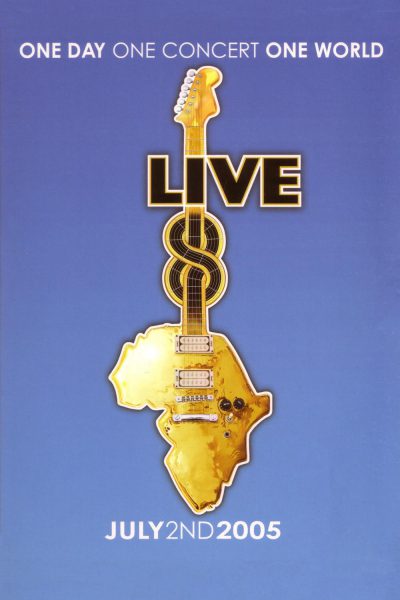
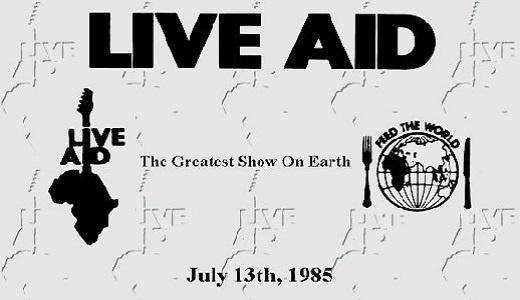
Larn
Images of starving Ethiopian children and harsh landscapes in famine moved the musicians Bob Geldof and Midge Ure to plan and host 'Alive Assistance' in 1985. Live Aid was an ambitious dual-venue music initiative, with concerts held at Wembley Stadium in London, the John F. Kennedy Stadium in Philadelphia and besides in Australia and Germany on the 13 July 1985. The concerts were broadcast to a global audience of almost ii million people and are reported to have straight raised over $100 million for famine relief.
The original black and white poster took on a variety of forms around the world. In this version the symbolism of the knife, fork and globe directly attention to aims of the fundraiser; the intention here was for the public to make donations to 'feed the world'.
Two decades later and the symbolism of the continent/guitar continues simply the blue and gold poster directs attention to a very dissimilar audience, that of the political leaders who grade the G8 (the Grouping of Eight highly industrialized nations (France, Frg, Italia, the Britain, Japan, the The states, Canada, and Russia) that concur an annual meeting to foster consensus on global issues like economical growth and crisis management, global security, free energy, and terrorism.
The series of 10 Live 8 benefit concerts had a different target to that of the Live Assistance events. Alive eight specifically targeted the G8 political leaders that were to meet for talks in Scotland in 2005. The aim was to demand that these world leaders have action to "Brand Poverty History". The Live 8 concerts led to G8 leaders pledging to double 2004 levels of aid, with half of these funds going to Africa.
To me, the 1985 affiche shows the stereotypical 'charity' mentality: aid from rich countries going to 'feed the world' (and in this specific case, for the Ethiopia famine relief). There'southward nix wrong with solving a straight issue, peculiarly when information technology comes to giving much-needed food help, but I believe the juxtaposition of this with the 'Live 8' affiche is important. The difference with the Live eight poster (2007) is that it focuses on the fact that we are 'one earth' (no more 'them' and 'us'). Although the original guitar imagery is still used, it's no longer only about aid period from north (rich) to south (poor), but nigh fixing the structural injustices that create and perpetuate poverty – the '8' on the guitar head focuses the solutions on the G8.
— Kate Phillips, Schools Program Coordinator, Oxfam Australia
Retrieve and Act
- A symbol is an image that stands for, or represents, an idea. Explicate the symbolism in both the Live Aid and Alive viii posters.
- Imagine that you accept been hired to program a concert for Oxfam. According to Oxfam: "Governments need to increase the corporeality of money they allocate to development and essential services, and employ that money to significantly meliorate the lives of the poorest and most vulnerable people — now and into the time to come." The concerts will not be about collecting money from the public; instead they are about raising awareness of the demand for government and the individual sector to play a leading part in contributing to and committing to responsible global development plans. Your job is to design a affiche to promote the concert; the concert must appeal to Australian families and accept place in your capital city. Alternatively, read the student workbook to discover 2 scenarios for music effect poster design
Follow these steps to complete your job:
- Read about Oxfam Australia's Goal number 6: 'Finance for Development' (page 24) and make a summary of this goal on a page in your journal.
- Make a list of the details that demand to go on the poster. This volition include the proper noun of the concert, date, location and possibly even the band names. You will need to make information technology clear that the concert is about raising awareness and showing a swell level of public support for this consequence. What kinds of imagery might you utilise to convey the idea? How might you use symbolism?
- Select 4 bands to play in the concert and explain why y'all have called these bands/artists.
- Sketch a crude plan for your poster. Remember to consider the size and calibration of the text, your use of the elements of design, symbolism and the bulletin you wish to convey. Handy tip: Have a look at a range of fundraising concert posters to get some ideas earlier you start. Y'all could exercise a Google Epitome or Pinterest search. Have a look at some OXJAM posters too!
- Share typhoon ideas that are documented in your journal with the grade. Discuss constructive strategies and take on peer feedback and cocky reflection.
- Utilise collage, markers, pencils or paint to piece of work on terminal designs. If you accept access to computers, this task could also be completed digitally.
Affiche 4: UN Women
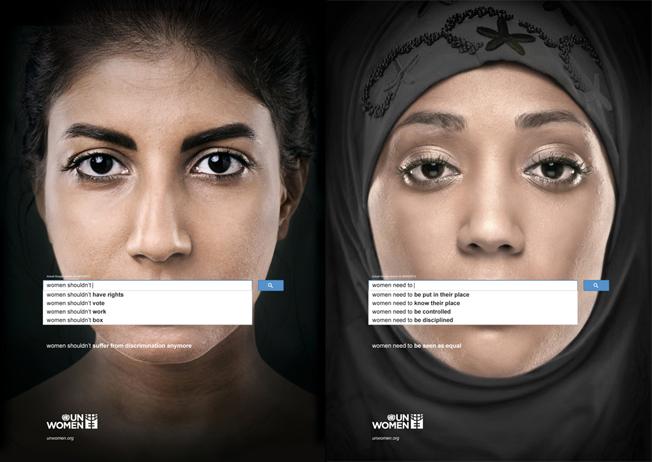
View up shut: UN women #1 and Un women #two
Acquire
Adult in 2013 for United nations Women past the advertising agency Memac Ogilvy & Mather Dubai, the posters in this serial used genuine Google search results to reveal the prevalence of gender inequality and discrimination against women online. There are four posters in total and each ane features a closely cropped photograph of a youthful female face against a dark background.
What is hit i that each woman's mouth is 'airtight' by a popular Google search query. The searches offset with phrases such as "women should…" or "women shouldn't…".
The bulletin about entrenched patriarchy in contemporary society is made clear by the negative Google search engine suggestions located below the search. The posters and online social campaign using the hashtag #womenshould, complemented by an online film, all convey the importance of the piece of work of United nations women and of the need to continue to brand the case for women'southward rights. This highly successful entrada won the agency Memac Ogilvy & Mather the 'Social Good Campaign' award in 2013 past Advertisement Agency and highlighted the work of United nations women internationally.
They're simple, and accessible (we all use Google), but carry such an instantly powerful bulletin well-nigh patriarchy and the manner it manifests itself in mod society. It has that 'heed blown' gene, for want of a ameliorate term, and the poster is very shareable.
— Kate Seewald, Community Apostle NSW/Deed Oxfam Commonwealth of australia
Think and Act
- Document this entrada in your design journal. You lot tin further research 'The Autocomplete Truth' entrada online.
- Look at the affiche by designer Steph Hughes on gender justice (one of Oxfam Australia's 'half-dozen goals to change the world'). This poster is made up of a series of small-scale connected images. Annotate six of the small images on the poster past explaining the detail gender justice consequence that the small prototype is drawing attention to.
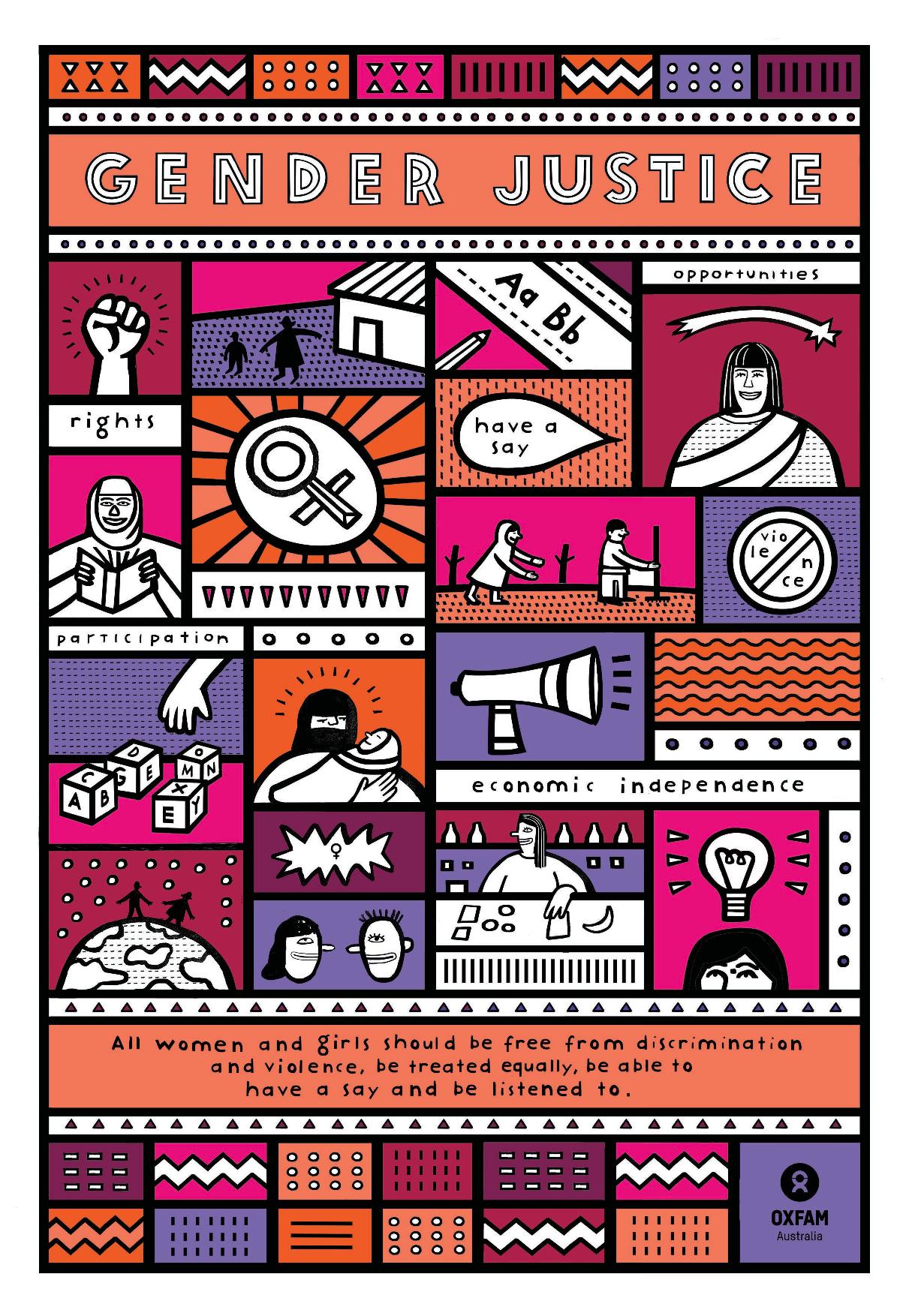
- Read virtually Goal two Gender Justice (page 18) and design a photographic affiche promoting gender justice or an aspect of gender justice. The poster must use a photograph of an object or series of objects. At that place are to be no people in the image(southward). Note: consider the ways that objects might exist organised to convey ideas and act as symbols. The poster will also need to have a articulate slogan promoting gender justice.
Affiche 5: Real Australians Say Welcome
Larn
In 2015 artist Peter Drew embarked on a three-calendar month trip around Commonwealth of australia pasting upward g brown paper posters he designed and printed with the large black words "Real Australians Say Welcome". The poster started every bit a way to encourage Australians to rethink their views on aviary seekers and immigrants. The campaign was successfully crowdfunded on Pozible and the artist documented his journeying via social media.
The campaign proved extremely successful. Many Australians documented the posters online equally they discovered them on the streets of local towns and big cities and hundreds of messages of support flooded in to Peter Drew. Hundreds of other designers, artists, and celebrities, inspired past Drew's work, have created their own versions of "Real Australians say welcome". These have been shared on Instagram and via the website "The Pattern Files".
"I dearest the "Existent Australians Say Welcome" entrada as it always seems to appear in places y'all to the lowest degree expect information technology, as a reminder of what truthful Australian values are and should be: inclusion, belonging and celebration of diverseness. It's a hopeful message and one that, in silence, speaks louder than the prototype of Australia that politicians and the media would accept us believe."
— Tamara Bézu, Volunteer Engagement Coordinator, Oxfam Australia
Call up and Human activity
- Await at the many appropriations of Peter Drew's "Existent Australians Say Welcome". You tin find examples on Instagram and through a elementary Google Image search. Create and share your own photographic version of the poster with the rest of the class. Remember to consider the ways that your use of materials, composition, cropping, and subject tin can be used to convey significant.
- Oxfam Australia's Goal iii 'Saving Lives: at present and in the hereafter' refers to humanitarian crises and the want that high-quality humanitarian assistance is provided to those affected by crunch, including those affected by climatic change and disaster. Working in pairs, imagine that yous have been hired to develop a affiche that uses typography but (no imagery) and encourages Australians to support international disaster and conflict relief. Create and print your posters.Annotation: y'all will need to consider very carefully your pick of words, typography and the layup of the text. You can read more virtually Goal 3 online.
- Document Peter Drew's practice in your design journals, for example past outlining his latest poster campaign "Aussie". Learn more than nigh Peter Drew'due south work.
Student Evaluation Task: What'south your favourite poster?
Add together to the choice of successful poster campaigns by choosing ane more successful campaign affiche that you lot recollect is effective.
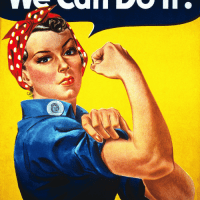
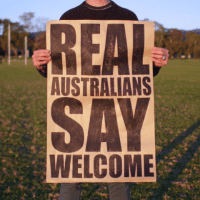

You need to:
- Upload your chosen poster and/or paste it into your
- Name the artist, the date of the work and the materials used to brand it.
- Describe the affiche using the elements of art.
Handy hint: Comment on the utilize of line, colour, tone, pattern, shape, calibration, composition, signs/symbols, focal point, typography and symbolism.
- Research and briefly outline the social issue or event to which this poster draws attending.
- Write a personal statement explaining what appeals to you about this affiche and why y'all discover it effective and persuasive.
Next
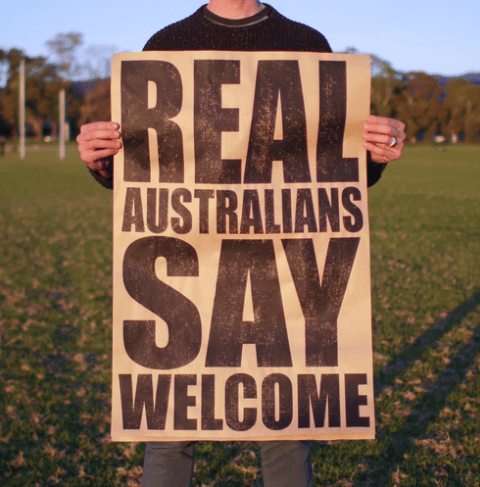
0 Response to "A Graphic Designer Developes a Campaign Poster The Purpose of Art It"
Post a Comment